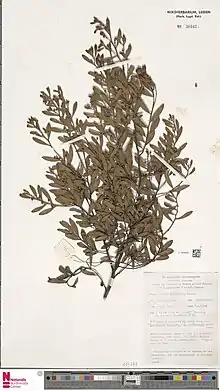| Sticky leaved wattle | |
|---|---|
 | |
| L1924464[1] | |
| Scientific classification | |
| Kingdom: | Plantae |
| Clade: | Tracheophytes |
| Clade: | Angiosperms |
| Clade: | Eudicots |
| Clade: | Rosids |
| Order: | Fabales |
| Family: | Fabaceae |
| Subfamily: | Caesalpinioideae |
| Clade: | Mimosoid clade |
| Genus: | Acacia |
| Species: | A. ixiophylla |
| Binomial name | |
| Acacia ixiophylla | |
 | |
| Occurrence data from AVH | |
Acacia ixiophylla, also known as sticky leaved wattle,[2] is a shrub of the genus Acacia and the subgenus Plurinerves that is endemic to coastal parts of eastern Australia.
Description
The shrub typically grows to a height of 1 to 4 m (3 ft 3 in to 13 ft 1 in) and has a spreading habit. It has hairy often viscid branchlets. Like most species of Acacia it has phyllodes rather than true leaves. The patent, leathery and evergreen phyllodes are sparsely to moderately densely haired and have a narrowly oblong to elliptic shape with a length of 2 to 4.5 cm (0.79 to 1.77 in) and a width of 2 to 10 mm (0.079 to 0.394 in) and have three to seven raised distant main nerves.[3] It blooms between August and October and produces simple inflorescences that occur in groups of two or three on axillary axes with a length of 1 to 8 mm (0.039 to 0.315 in) and has spherical flower-heads with a diameter of 4 to 8 mm (0.16 to 0.31 in) containing 20 to 35 yellow to deep yellow flowers.[2]
Taxonomy
The species was first formally described by the botanist George Bentham in 1842 as part of the William Jackson Hooker work Notes on Mimoseae, with a synopsis of species as published in the London Journal of Botany. It was reclassified as Racosperma ixiophyllum by Leslie Pedley in 1987 then transferred back to genus Acacia in 2001. The only other synonyms are; Acacia fuliginea and Acacia venulosa var. lanata.[4] The specific epithet is in reference to the sticky or viscid nature of the phyllodes. A. ixiophylla closely resembles Acacia montana.[2]
Distribution
The bulk of the population is found along the western plains and slopes down the Great Dividing Range from near Mount Wilson in New South Wales in the south to around Miles in Queensland in the north. Other smaller populations are found even further north around Jericho and Alpha where it grows in gravelly and sandy soils as a part of woodland containing species of Casuarina, Eucalyptus and Callitris.[3]
See also
References
- ↑ "Acacia ixiophylla L1924464". GBIF. Retrieved 2020-11-30.
- 1 2 3 "Acacia ixiophylla Benth". PlantNet. Royal Botanic Garden, Sydney. Retrieved 26 October 2020.
- 1 2 "Acacia ixiophylla". World Wide Wattle. Western Australian Herbarium. Retrieved 26 October 2020.
- ↑ "Acacia ixiophylla Benth". Atlas of Living Australia. Global Biodiversity Information Facility. Retrieved 20 November 2020.